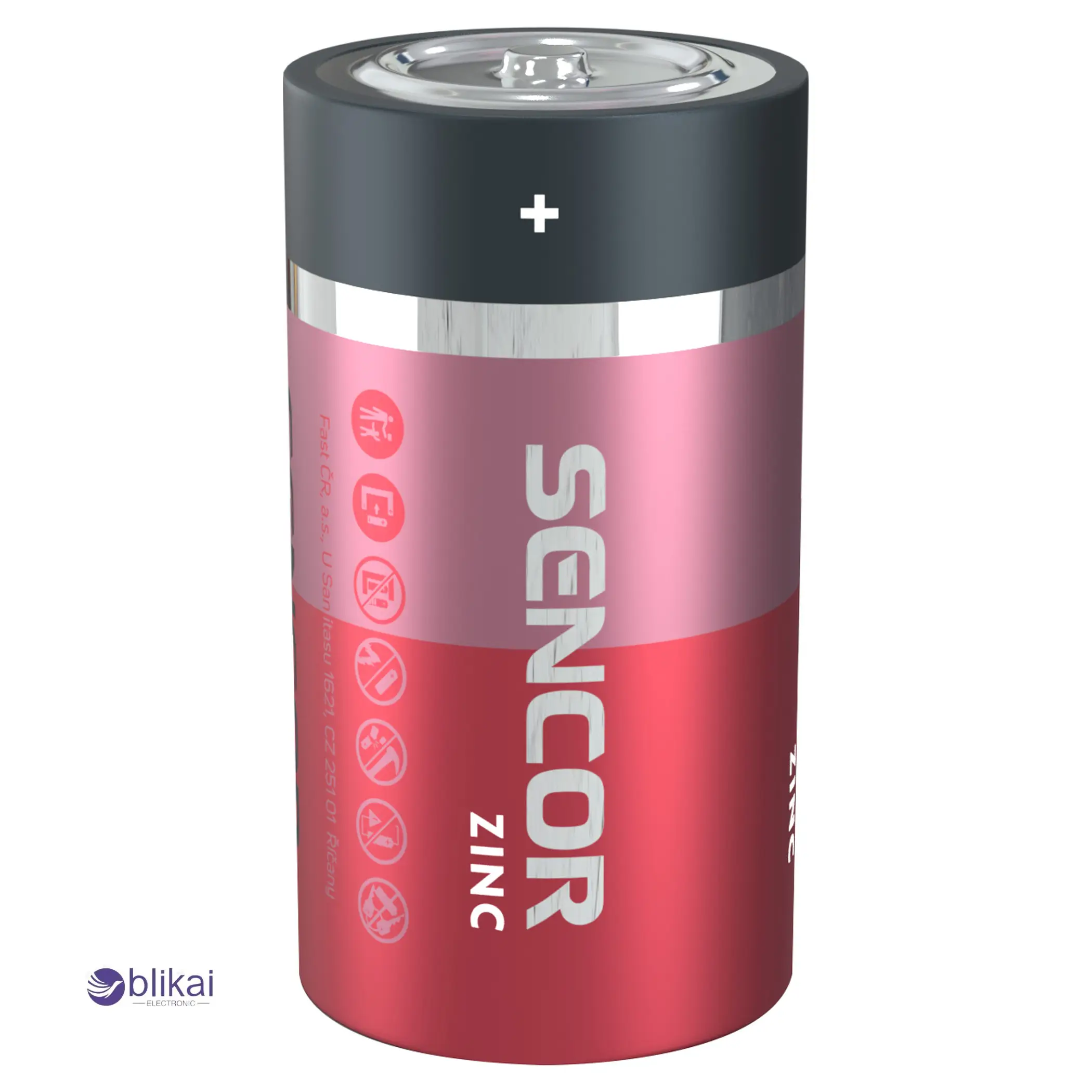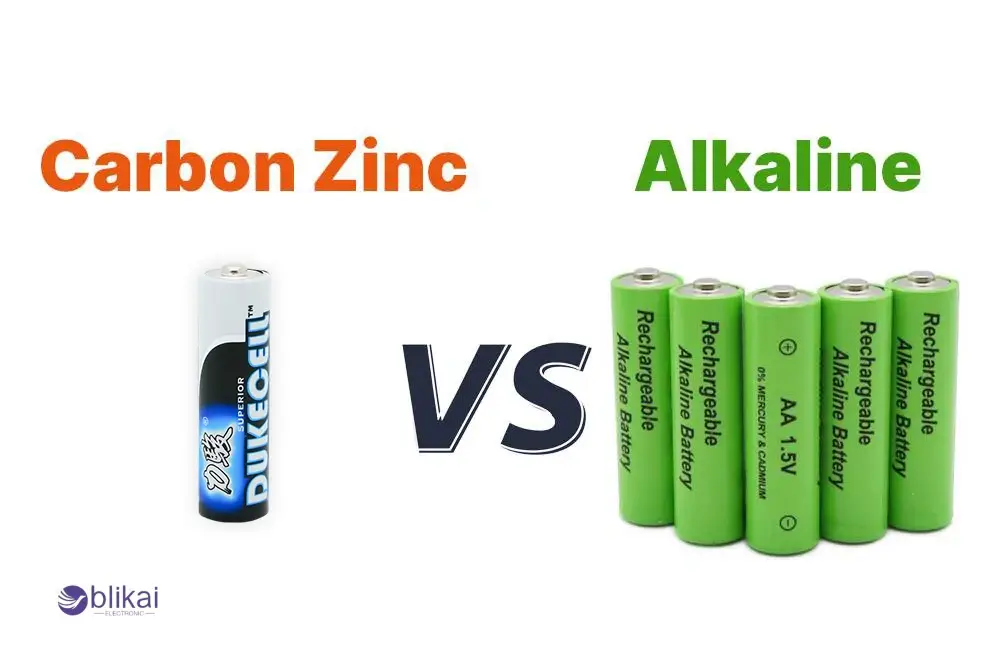Carbon Zinc Battery: Applications, Pros & Key Differences
What Is a Carbon Zinc Battery?
A carbon zinc battery is one of the oldest and most popular (non-rechargeable) types of primary batteries. It is a basic electrochemical system capable of providing reliable power to low-drain gadgets, such as remote controls, wall clocks and flashlights. The type of battery was popular before the alkaline batteries emerged, and it is still popular because it is cheap and accessible. The name carbon zinc had been derived due to the two primary materials used in the construction of zinc and carbon, which are combinations that generate electrical power by ordinary chemical reaction.

Basic Composition and Structure
A carbon zinc battery is basically a zinc anode, a carbon cathode, as well as an electrolyte that can be made of manganese dioxide and ammonium chloride or zinc chloride, mostly. The container and negative electrode are constructed with zinc, and the positive electrode is constructed with the carbon rod with which the manganese dioxide mixture is encircled. During the running of the battery, the following chemical reactions occur between these materials, and the electrons can flow out of the zinc to the carbon with the assistance of an external circuit. This flow of electrons results in electricity, which is utilized to give power to machines.
How It Produces Electrical Energy
The carbon zinc battery is a reduction and oxidation mechanism for producing electricity. When the circuit is completed, the anode of zinc oxidizes, giving out the electrons and the manganese dioxide in the cathode is reduced, which takes in the electrons. The electrolyte is applied in order to make the two electrodes push the ions in between them so as to maintain the chemical balance of the battery. The reactions gradually exhaust the zinc and deplete the chemical material; however, they generate a steady, low voltage level, typically approximately 1.5 volts, until the battery is drained.
Common Forms and Sizes
Carbon zinc batteries come in various common sizes and forms, which means that they can be used with many daily devices. The most common ones are the AA, AAA, C and D cells, commonly described as the ones that are of the Heavy Duty or the General Purpose batteries. Smaller buttons or cylindrical ones are also available in portable radios, flashlights and toys. As battery replacements in most of the applications are being substituted with alkaline and rechargeable batteries, their affordability and ease of use still make them a viable option when it comes to light-use or backup power.
Common Applications of Carbon Zinc Batteries
Low-Drain Devices
The most common usage of carbon zinc batteries is in low-drain electronic devices. These are remote controls, wall clocks, flashlights, TV remotes, small radios, and simple toys. These devices do not require high bursts of energy, which is appropriate to the rather low capacity of carbon zinc chemistry. Due to a constant output of 1.5V and low price, these have been a popular choice for decades. Carbon zinc batteries are good to use in simple and rarely used gadgets that do not require costly replacement and battery handling.
Inexpensive or Disposable Electronics
Carbon zinc batteries are regularly used in low-cost or disposable electronics due to being inexpensive and not limited to a single supplier. These batteries are the perfect fit for many low-energy-consuming devices, being budget-friendly. Manufacturers are more inclined to use carbon zinc in low-cost products like simple flashlights, children's toys, and promotional gadgets, where the need for a long battery life is not as much as the cost-effectiveness.
Emergency or Backup Use
As they are cheap and have a fair shelf life, they are usually kept by people as flashlights, portable radios, or emergency lanterns to use in times of power failure. They are able to remain idle over a long period of time and provide sufficient energy on demand, particularly in low-drainage applications. This affordability, availability, and reliable performance on a short-term basis make them a reasonable alternative backup power source in most households.
Advantages and Disadvantages of Carbon Zinc Batteries
Advantages
Affordable and Widely Available
The low cost and high availability of carbon zinc batteries are one of the greatest benefits of this type of battery. They are also one of the cheapest primary batteries in the market, thus a cost-effective alternative both to consumers and manufacturers.
Reliable for Low-Drain Devices
Carbon zinc batteries are very effective in low-drain applications where the amount of power required is minimal and constant. Electrical powered devices such as wall clocks, remote controls and flashlights that are very small can be used with such batteries since they just need a continuous, low power of electricity. The chemical process in the battery gives a stable 1.5-volt output during light usage over a reasonable duration.
Environmentally Safer and Easy to Dispose Of
They are not filled with very toxic substances like mercury, cadmium, and lead, which were previously utilized in batteries and ended up posing a great environmental threat. It is easier and safer to dispose of, and when possible, the best alternative is recycling. They can be disposed of together with other household wastes without significant environmental consequences in most areas.
Disadvantages
Short Lifespan and Limited Capacity
They are also less thick, and thus they cannot hold as much charge, and they are also emptied at a much higher rate. This makes them not so reliable in relation to gadgets that consume a lot of power, like digital cameras, wireless mice or portable speakers. The voltage declines swiftly as the charge declines and is capable of causing devices to grow dim, sluggish, or end earlier than expected.
Sensitivity to Temperature and Leakage Issues
Extreme temperatures of either hot or cold are not good for carbon zinc batteries since they do not react as quickly or as slowly as needed and therefore lack efficiency and life span. Such batteries may also spurt acidic electrolyte with the course of time, especially when they are kept in a not so good way that would result in corroding battery terminals or damage those devices.
Which Is Better, Alkaline or Carbon Zinc Batteries?
Overall Performance Comparison
In the comparison of the alkaline and carbon zinc battery, alkaline batteries are regarded as better in terms of overall performance. They offer better energy density, increased life and more constant voltage output. This makes them suitable for power-greedy products such as flashlights, cameras and portable radios. Carbon zinc batteries are weaker, but can be used in low-drain products, like a remote control or a clock, to a satisfactory degree. Compared to the carbon zinc cells, the alkaline batteries have the capacity to provide more power as time progresses because the latter can lose power faster. As such, alkaline batteries are the choice and more reliable in most modern electronic devices.

Best Use Scenarios for Each Type
The decision on alkaline and carbon zinc batteries will mostly depend on the gadget and the number of times of use. Carbon zinc batteries provide a good, cost-effective alternative to lithium-ion batteries in low-drain or disposable electronics, such as television remotes, small toys, or emergency flashlights. They are cheap, readily available and can be applied to the devices that are occasionally used. But with high-drain devices or those that are used on a regular basis, such as wireless keyboards, flashlights or audio players, alkaline batteries are much better. They are also more effective and secure to work in the long term, and provide protection against leakage and stable power.
Balancing Cost, Performance, and Environmental Impact
The carbon zinc batteries are cheap and less resource-consuming to make, and hence can be employed on simple and short-term applications. A significant increase in cost, alkaline batteries have a far longer life span and eliminate the necessity to replace them nearly as often, meaning they produce less total waste. The two are mercury-free and comparatively safe to dispose of, although recycling is the most responsible thing to do; after all, the all-around performance is better in alkaline batteries, whereas carbon zinc batteries are still an option in terms of affordability and strenuous usage.
Conclusion
The carbon zinc battery is still one of the most famous and less expensive sources of power in daily life. It has a more primitive technology, but easy chemistry and low cost of production still make it an option for low-drain devices and low-end products like flashlights, clocks and remotes. Although it is not as effective, or may be short-lived, as modern alkaline batteries, it has a role to play in those applications where a relatively small amount of power is needed.
FAQ
Are carbon zinc batteries rechargeable?
No, the carbon zinc batteries are not rechargeable. They are single use cells that are supposed to be replaced every time they are exhausted to prevent leakage or inefficient work.
How long do carbon zinc batteries last?
With low-drain gadgets, carbon zinc batteries have an average life of one to two years.
Can I use carbon zinc batteries instead of alkaline?
Yes, but not high-drain devices such as cameras or mobile phones. In high-drain devices, alkaline batteries have a longer life, and they offer more reliable voltage performance.
Some images are sourced online. Please contact us for removal if any copyright concerns arise.
18500 Battery: Features, Applications & Comparison
L1131 Battery Equivalent: Features & Applications
Battery Desulfator: How It Works & Why It Matters
A27 Battery: Lifespan, Applications & Alternatives
CR2477 Battery: Features, Applications & Lifespan
1/3N Battery: Applications, Lifespan, & Key Features Explained
NMC Battery vs. LFP Battery: A Detailed Comparison
EFB Battery vs. AGM Battery: Comparing the Differences
Dry Cell Battery vs Wet Cell Battery: Differences
NiCd Battery vs NiMH Battery: Differences










